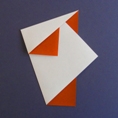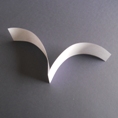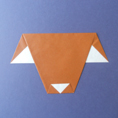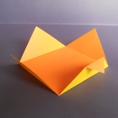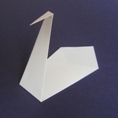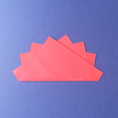| Origami Heaven A paperfolding paradise The website of writer and paperfolding designer David Mitchell x |
|||||||||||||
|
|||||||||||||
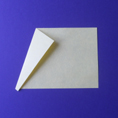 |
|||||||||||||
| Minimalist representational origami is a
form of origami that seeks to capture the essence of a
subject in the smallest possible number of folds. Such
designs may be made using either single sheets or
multiple sheets. Because of the aim to use as few folds as possible the subject must be suggested rather than modelled in detail and so minimalist representational designs will tend to be impressionistic and to concentrate on those details of the subject which are essential to recognition and ignore those that are not. The very best minimalist designs are instantly recognisable. Persuading your friends to recognise others may require a subtle hint. 'It's a stegosaurus,' usually works, for instance. In general children seem to recognise many minimalist designs on first sight much more easily than adults do. Minimalist representational designs need not just be just straightforward representations. You will also find examples of minimalist representational action folds, double images, visual illusions, surprise denouement and conceptual origami designs. In thinking about minimalist origami of all kinds it is useful to distinguish between active and passive folds, active folds being folds which are used in the final design and passive folds being folds used to create location points which are not then used in the final design. I only count the active folds when considering the number of folds that a design requires. I define a fold as a change of direction in the plane of the paper. It is not necessary to create a crease to create a fold. A simple curve is a fold. A complex curve may be several. Minimalist Representational designs may be folded from either a single sheet or from multiple sheets and in several distinct styles: Single Sheet Minimalist Representational Origami There is no absolute upper limit on the number of folds that can be used in a single sheet minimalist representational design. A more difficult subject may require more details, and hence more folds. Achieving a good result using five active folds or less is usually reckoned to be pretty creditable. Doing the same thing in just one active fold is clearly outstanding. Multiple Sheet Minimalist Representational Origami In the case of multiple sheet designs it seems sensible to think of each part of the overall design as a separate minimalist element. I would regard a multiple sheet design as minimalist if each of the elements was made using the smallest possible number of active folds ... or, at least, a very small number ... irrespective of the total number of folds in the design as a whole. Styles of Minimalist Representational Origami There are (at least) four different styles of single sheet minimalist origami which I call the three-dimensional, pictorial, hybrid and naive styles. Naive designs are not necessarily minimalist but are likely to be because of their simplicity. The archetypal three-dimensional minimalist representational design is the tent made by folding a square of paper in half and arranging it like this:
Pictorial minimalist representational designs may depend purely on outline shape or on being folded from irogami (paper that is white one side and a single plain colour the other) so that the contrast between the two sides of the paper can be used to sketch a simple picture, like this:
Seiryo Takegawa's 'Mount Fuji and the Sea', was one of the earliest attempts at a minimalist style design, and was influential in the development of the style. It combines both pictorial and three-dimensional elements. However, as it uses 12 active folds it cannot really be considered minimalist in the paperfolding sense.
Some specimen minimalist designs are shown below. A page giving details of my own contributions to the minimalist representational genre can be found here. Very simple paperfolds were used by Froebel and his followers to help children develop an understanding of mathematical concepts. Over time some of these very simple folds, such as the tent shown above, which is also known as the book, were given names and treated as Lebensformen (Forms of Life). Giving a name to a very simple paperfold is not quite the same thing as seeking to capture the essence of a subject in the smallest possible number of folds, but it is difficult to maintain the distinction in practice. |
|||||||||||||
| Single Sheet Minimalist Representational Designs | |||||||||||||
| 1 Active Fold | |||||||||||||
|
|||||||||||||
|
|||||||||||||
|
|||||||||||||
| 2 Active Folds | |||||||||||||
|
|||||||||||||
| 3 Active Folds | |||||||||||||
|
|||||||||||||
|
|||||||||||||
| 4 Active Folds | |||||||||||||
|
|||||||||||||
| 5 Active Folds | |||||||||||||
|
|||||||||||||
|
|||||||||||||
| Multiple Sheet Minimalist Representational Designs | |||||||||||||
|
|||||||||||||
|
|||||||||||||

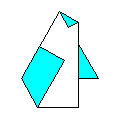
.jpg)
